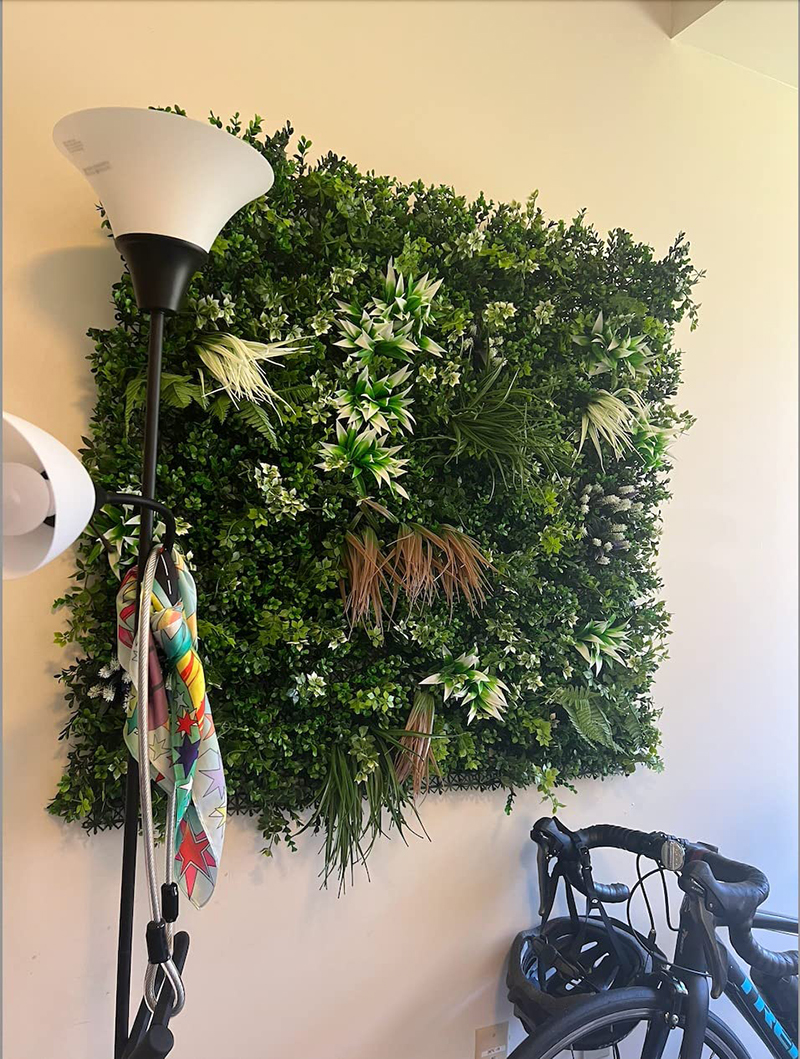Drought-Tolerant Plant Arrangements for 3D Artificial Vertical Gardens: Designing Low-Maintenance Green Walls for Arid and Sun-Exposed Spaces
Artificial vertical gardens are ideal for areas with limited water access or intense sunlight, such as desert landscapes, rooftop terraces, or Mediterranean-climate zones. By selecting drought-resistant plant designs, these gardens can replicate the resilience of real xeriscape species while requiring no irrigation. Below are strategies for combining artificial plants to create striking, water-wise green walls in dry environments.

Even without water needs, artificial plants can mimic the textures, shapes, and colors of species adapted to drought conditions. This ensures a cohesive, desert-inspired aesthetic.
Succulent-Inspired Designs: Use artificial plants with thick, fleshy leaves or stems, such as those resembling echeveria, agave, or aloe. These designs replicate the water-storage adaptations of real succulents and add a sculptural quality to vertical gardens.
Gray-Green Foliage for Heat Reflection: Incorporate artificial plants with silvery or blue-gray leaves, like those inspired by lavender, sage, or olive trees. These hues mimic the natural coloration of plants that reflect sunlight to stay cool in hot climates.
Spiky or Rosette-Forming Accents: Introduce artificial cacti, yucca, or hen-and-chicks to add contrast. Their bold shapes and sharp textures evoke the rugged beauty of desert landscapes.
Drought-tolerant gardens often feature a mix of compact and sprawling plants. Artificial designs can use this principle to add dynamic energy without the need for pruning or trimming.
Combining Compact and Spreading Forms: Pair artificial succulents with low, mounding habits, like artificial sedum or sempervivum, with taller, more upright varieties such as agave. This creates a layered effect that mimics the way real desert plants grow in clusters.
Using Vertical Space with Vining Varieties: Incorporate artificial trailing plants like string-of-pearls or artificial donkey tail spilling over the edges of panels. These designs add movement and soften the sharp lines of spiky plants.
Balancing Dense and Airy Textures: Mix artificial plants with tightly packed leaves, such as echeveria rosettes, with those featuring more open, airy structures, like artificial yucca or Joshua tree branches. This contrast prevents the garden from looking overly heavy.
Drought-tolerant plants often feature muted earth tones or bold pops of color. Artificial designs can draw from these natural hues to create a harmonious, sun-baked aesthetic.
Earth-Toned Neutrals: Stick to shades of sandy beige, terracotta, or dusty brown to evoke the look of desert soils and rocks. These colors work well as backdrops for more vibrant plants.
Subdued Greens with Gray Undertones: Use artificial plants in shades like sage, olive, or dusty green to replicate the way real desert foliage adapts to conserve water. These tones blend seamlessly with stone or concrete surfaces.
Accents of Bright Color: Introduce artificial flowers or leaves in shades of orange, yellow, or deep red to mimic the occasional bursts of color found in desert blooms. Use these sparingly to highlight focal points or add energy.
Desert ecosystems thrive on texture, from smooth stones to prickly cacti. Artificial gardens can replicate this diversity to create a tactile, engaging display.
Rough, Waxy Surfaces: Combine artificial plants with thick, glossy leaves, like those mimicking aloe or agave, with those featuring rough, matte textures, such as artificial yucca or barrel cacti. This contrast adds depth and realism.
Fine, Spiky Details: Use artificial plants with thin, needle-like leaves or spines, like those inspired by cholla cactus or ocotillo, to add a sense of sharpness. These elements work well as accents between softer plants.
Soft, Fuzzy Foliage: Introduce artificial plants with woolly or hairy leaves, like those resembling lamb’s ear or desert sage, to add a tactile quality. These designs soften the overall look and evoke the way real desert plants protect themselves from sun and wind.
By focusing on drought-resistant plant designs, contrasting forms, desert-inspired color palettes, and textural diversity, artificial plants can transform 3D vertical gardens into water-wise oases. Their durability and low-maintenance nature make them ideal for sun-drenched spaces, ensuring year-round beauty without the need for irrigation, fertilizers, or ongoing care.
Contact: Amy
Phone: 86-15311787313
E-mail: info@foszmac.com
Whatsapp:86-15311787313
Add: Fengtai District, Dacheng Road, No.24 Building, Room 203, Beijing, China